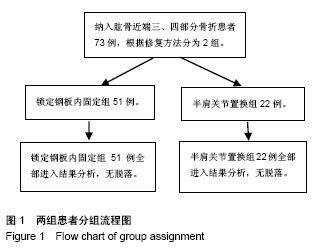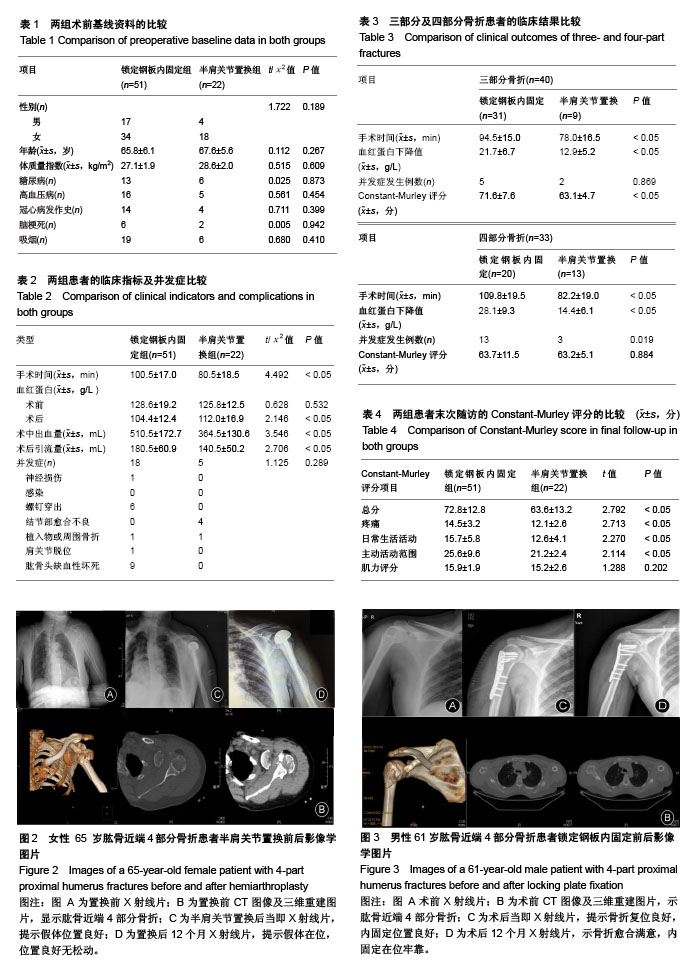| [1] Courtbrown CM, Caesar B. Epidemiology of adult fractures: A review. Injury. 2006;37(8): 691.[2] Baron JA, Barrett JA, Karagas MR. The epidemiology of peripheral fractures. Bone.1996;18(3): 209S-213S.[3] Khatib O, Onyekwelu I, Zuckerman JD. The incidence of proximal humeral fractures in New York State from 1990 through 2010 with an emphasis on operative management in patients aged 65 years or older. J Shoulder Elbow Surg. 2014; 23(9): 1356-1362.[4] Palvanen M, Kannus P, Niemi S, et al. Update in the epidemiology of proximal humeral fractures. Clin Orthop Relat Res. 2006;442: 87-92.[5] Guy P, Slobogean GP, Mccormack RG. Treatment preferences for displaced three- and four-part proximal humerus fractures. J Orthop Trauma. 2010;24(4): 250.[6] Rabi S, Evaniew N, Sprague SA, et al. Operative vs non-operative management of displaced proximal humeral fractures in the elderly: A systematic review and meta-analysis of randomized controlled trials. World J Orthop. 2015;6(10): 838.[7] Slobogean GP, Johal H, Lefaivre KA, et al. A scoping review of the proximal humerus fracture literature. Bmc Musculoskelet Disord. 2015; 16(1): 112.[8] Sebastiáforcada E, Cebriángómez R, Lizaurutrilla A, et al. Reverse shoulder arthroplasty versus hemiarthroplasty for acute proximal humeral fractures. A blinded, randomized, controlled, prospective study. J Shoulder Elbow Surg. 2014; 23(10): 1419-1426.[9] Shukla DR, Mcanany S, Kim J, et al. Hemiarthroplasty versus reverse shoulder arthroplasty for treatment of proximal humeral fractures: a meta-analysis. J Shoulder Elbow Surg. 2016;25(2): 330-340.[10] Cuff DJ, Pupello DR. Comparison of hemiarthroplasty and reverse shoulder arthroplasty for the treatment of proximal humeral fractures in elderly patients. J Bone Joint Surg Am. 2013;22(10): 2050.[11] Wild JR, Demers A, French R, et al. Functional outcomes for surgically treated 3- and 4-part proximal humerus fractures. Orthopedics. 2011;34(10): e629.[12] Bonnevialle N, Tournier C, Clavert P, et al. Hemiarthroplasty versus reverse shoulder arthroplasty in 4-part displaced fractures of the proximal humerus: Multicenter retrospective study. Orthop Traumatol Surg Res.2016;102(5): 569-573.[13] Andrés-Cano P, Galán A, Arenas J, et al. Results of uncemented hemiarthroplasty as primary treatment of severe proximal humerus fractures in the elderly. Eur J Orthop Surg Traumatol. 2015;25(2): 273-280.[14] Park YK, Kim JK, Kwon J, et al. Intermediate-term outcome of hemiarthroplasty for the comminuted proximal humerus fracture. J Shoulder Elbow Surg. 2016.[15] White JJE, Soothill JR, Morgan M, et al. Outcomes for a large metaphyseal volume hemiarthroplasty in complex fractures of the proximal humerus. J Shoulder Elbow Surg. 2016;26(3): 478-483.[16] Kralinger F, Schwaiger R, Wambacher M, et al. Outcome after primary hemiarthroplasty for fracture of the head of the humerus. A retrospective multicentre study of 167 patients. J Bone Joint Surg Br. 2004;86(2): 217.[17] Gupta AK, Harris JD, Erickson BJ, et al. Surgical management of complex proximal humerus fractures-a systematic review of 92 studies including 4500 patients. J Orthop Trauma. 2015;29(1): 54.[18] Fialka C, Stampfl P, Arbes S, et al. Primary hemiarthroplasty in four-part fractures of the proximal humerus: Randomized trial of two different implant systems. J Shoulder Elbow Surg. 2008;17(2): 210-215.[19] Hashiguchi H, Iwashita S, Ohkubo A, et al. The outcome of hemiarthroplasty for proximal humeral fractures is dependent on the status of the rotator cuff. Int Orthop. 2015;39(6): 1115-1119.[20] Moineau G, Jr MCW, Trojani C, et al. Prognostic factors and limitations of anatomic shoulder arthroplasty for the treatment of posttraumatic cephalic collapse or necrosis (type-1 proximal humeral fracture sequelae). J Bone Joint Surg Am. 2012;94(23): 2186.[21] Saporito M, Merolla G, Campi F, et al. Malunion of Humeral Tuberosity Fractures: Springer Milan, 2015.[22] Misra A, Kapur R, Maffulli N. Complex proximal humeral fractures in adults--a systematic review of management. Injury. 2001;32(5): 363-372.[23] Gavaskar AS, Karthik BB, Tummala NC, et al. Second generation locked plating for complex proximal humerus fractures in very elderly patients. Injury. 2016;47(11): 2534-2538.[24] Fattoretto D, Borgo A, Iacobellis C. The treatment of complex proximal humeral fractures: analysis of the results of 55 cases treated with PHILOS plate. Musculoskelet Surg. 2016;100(2): 1-6.[25] Rotini R, Cavaciocchi M, Fabbri D, et al. Proximal humeral fracture fixation: multicenter study with carbon fiber peek plate. Musculoskelet Surg. 2015;99 Suppl 1(1): 1-8.[26] Brunner A, Thormann S, Babst R. Minimally invasive percutaneous plating of proximal humeral shaft fractures with the Proximal Humerus Internal Locking System (PHILOS). J Shoulder Elbow Surg. 2012;21(8): 1056-1063.[27] Dai J, Chai Y, Wang C, et al. Meta-analysis comparing locking plate fixation with hemiarthroplasty for complex proximal humeral fractures. Eur J Orthop Surg Traumatol. 2014;24(3): 305-313.[28] Duralde XA, Leddy LR. The results of ORIF of displaced unstable proximal humeral fractures using a locking plate. J Shoulder Elbow Surg. 2010;19(4): 480-488.[29] Schliemann B, Theisen C, Kösters C, et al. Complex fractures of the proximal humerus in the elderly—outcome and complications after locking plate fixation. Musculoskelet Surg. 2012;96 Suppl 1(1): S3.[30] Brorson S, Frich LH, Winther A, et al. Locking plate osteosynthesis in displaced 4-part fractures of the proximal humerus. Acta Orthopaedica. 2011;43(7): 475-481.[31] Ortmaier R, Filzmaier V, Hitzl W, et al. Comparison between minimally invasive, percutaneous osteosynthesis and locking plate osteosynthesis in 3-and 4-part proximal humerus fractures. Bmc Musculoskelet Disord. 2015;16(1): 297.[32] Aguado HJ, Mingo J, Torres M, et al. Minimally invasive polyaxial locking plate osteosynthesis for 3-4 part proximal humeral fractures: our institutional experience. Injury. 2016;47: S22-S28.[33] Geiger EV, Maier M, Kelm A, et al. Functional outcome and complications following PHILOS plate fixation in proximal humeral fractures. Acta Orthopaedica Et Traumatologica Turcica. 2010;44(1): 1.[34] AS P, S S, U O, et al. Locking plate fixation of three- and four-part proximal humeral fractures. Acta Orthopaedica Et Traumatologica Turcica. 2010;44(2): 97.[35] Thanasas C, Kontakis G, Angoules A, et al. Treatment of proximal humerus fractures with locking plates: a systematic review. J Shoulder Elbow Surg. 2009;18(6): 837.[36] Brunner F, Sommer C, Bahrs C, et al. Open reduction and internal fixation of proximal humerus fractures using a proximal humeral locked plate: a prospective multicenter analysis. J Orthop Trauma. 2009;23(3): 163.[37] Schliemann B, Siemoneit J, Ch T, et al. Complex fractures of the proximal humerus in the elderly--outcome and complications after locking plate fixation. Musculoskelet Surg. 2012;96 Suppl 1(1): S3.[38] Hente R, Kampshoff J, Kinner B, et al. Treatment of dislocated 3- and 4-part fractures of the proximal humerus with an angle-stabilizing fixation plate. Der Unfallchirurg. 2004;107(9): 769-782.[39] Peter H, Christian B, Björn E, et al. Does fixed-angle plate osteosynthesis solve the problems of a fractured proximal humerus? Acta Orthopaedica. 2009;80(1): 92-96.[40] Konrad G, Hirschmüller A, Audige L, et al. Comparison of two different locking plates for two-, three- and four-part proximal humeral fractures--results of an international multicentre study. Int Orthop. 2012;36(5): 1051.[41] Aksu N, Gö?ü? A, Kara AN, et al. Complications encountered in proximal humerus fractures treated with locking plate fixation. Acta Orthopaedica Et Traumatologica Turcica. 2010; 44(2): 89-96. |
.jpg) 文题释义:
文题释义:

.jpg) 文题释义:
文题释义: